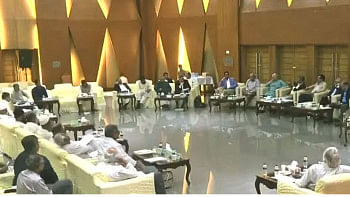A tangled web of bottlenecks

"In certain haor areas of Sylhet, one bad season, one flash flood is all it takes for a farmer to lose everything. These farmers are left with no options but to migrate to Dhaka and take up menial jobs such as security guards," said a high-level representative of the Department of Agricultural Marketing as he was being interviewed for a study on microinsurance.
Intercepts of these interviews keep ruminating on my mind as I read up on the devastating flood in Sylhet where 72 per cent of the entire division went underwater. According to the Sylhet district administration, the flood affected more than 389,000 families in the district, damaging about 22,000 homes and almost 29,000 hectares of cropland.
The extensiveness of the catastrophe should not come to us as a surprise as Bangladesh is ranked fifth in the world in terms of economic losses due to climate change and has experienced more than $3.7 billion of losses from 2000 to 2019. According to a study, Bangladesh is the seventh most climate change-vulnerable country in the world with approximately 56 per cent, or 9 crore, of its population living in "high climate exposure areas".
The insurance sector can play a significant role in the coverage of risks of the climate-vulnerable people of the country through various products such as climate risk insurance, crop microinsurance and livestock microinsurance.
According to the Insurance Development Forum, a 1 per cent increase in insurance penetration can reduce the disaster recovery burden on taxpayers by up to 22 per cent. Despite the potential benefits, the insurance penetration in Bangladesh remains at 0.4 per cent, failing to reach even half of a single-digit penetration.
What is holding up our insurance sector, particularly the microinsurance sector?
A Market System Analysis (MSA) study by Innovision Consulting identified the bottlenecks of the sector.
Global evidence suggests microinsurance can boost economic performance and build resilience by stimulating risk appetite and the shock absorption capacity of enterprises, particularly smallholder farmers. Microinsurance, in fact, is not new in Bangladesh and has existed since 1972 when Brac launched health insurance schemes that were micro in nature. There have been at least 17 microinsurance-based projects since then.
Despite its 50-year-long presence, the microinsurance sector still has no regulatory framework. The Insurance Development Regulatory Authority (IDRA), the regulatory body for insurance that is at par with the Bangladesh Bank or the Microcredit Regulatory Authority, despite being formed 12 years ago, has failed to provide even an official definition of microinsurance, let alone any regulatory framework.
Furthermore, ambiguity in the 2006 MRA Act and the 2010 Insurance Act caused confusion in regards to who can provide insurance services. This has caused a decade-long discomfort between not only the regulators but also insurance and microfinance organisations (MFIs).
However, the IDRA has since taken a firm stance that it should regulate both insurance and microinsurance services and that only insurance companies should provide insurance. Insurance companies, albeit do not oppose microinsurance, resist the sales of insurance/microinsurance by MFIs.
Microinsurance experts, however, think that MFIs have an unparalleled position to expand and significantly grow the microinsurance market. But due to the regulatory bottleneck, MFIs are providing insurance services under the alias of risk mitigation services or client welfare services.
These services are essentially mandatory credit shield services where risk coverage is provided to the credit amount in addition to some extension services. The scope of these services is very limited as they are not able to operate under the domain of formal insurance per se.
The microinsurance sector also has further political complexities. Microinsurance is deeply connected to agriculture (particularly crop and livestock) insurance as the majority of the microcredit schemes provided by MFIs are crop loans and around 40 per cent of MFI clients invest their microcredit in livestock rearing.
Despite the inter-connectedness of the agricultural sector, the agriculture ministry has vehemently opposed crop insurance and is firmly against any form of subsidies for microinsurance, particularly the premium, fearing that they will discourage farmers to increase productivity. This fear primarily stems from a few high-level officials in the ministry. Consequently, this limited inter-ministry collaboration or the use of political power to enhance the microinsurance market.
Over the last decade, development partners have invested approximately $250 million in microinsurance projects. Most of these have not been successful in reaching either scale, sustainability, or profitability.
In many of these projects, in addition to project costs, the premiums have also been subsidised. This has caused new potential projects to consider subsidies that may not even be necessary as preceding projects have been heavily subsidised. Moreover, development projects have primarily catered to the crop and agriculture sector and have left out other potential sectors.
Apart from these, there is a multitude of complex issues that scar the insurance and microinsurance sector. Of them, a major issue is the lack of product development.
In order to develop insurance products, the specialised skill of actuarial science is necessary. Despite the IDRA mandating insurance companies to invest and develop actuaries, there are only six actuaries in Bangladesh. Most companies use international actuary consultants for product development which again limits the scope as a product may need further optimisation as it is launched into the market.
Furthermore, because actuarial science is nascent in Bangladesh, the IDRA developed a tariff system in the non-life sector where insurance products and their prices are set by the IDRA and the Central Rating Committee. This removes the need for innovation in product development since insurance companies do not require actuaries further or feel the need to develop skills in the field of product development.
In addition to this, most microinsurance services are predominantly in the domain of MFIs where the risk premium is fixed. Therefore, there is no need for actuaries to price premiums. This has caused a gap in the product-market-fit for insurance and microinsurance products.
All in all, the current demand for insurance and microinsurance is very low. This could be largely contributed to a lack of awareness of the benefits of microinsurance, a lack of trust in the concept of insurance and insurance companies, and existing products that do not meet the risk needs of beneficiaries.
The only positive aspect of very low penetration of insurance is that it has a strong scope of going up.
In the market system analysis study conducted by Innovision Consulting Pvt Ltd, we found that if 5 per cent of the total cropped land (3.97 crore acres) were brought under microinsurance, the crop microinsurance market size alone will stand at $547 million.
In spite of the current low demand, impressive growth can come from more than 3 crore smallholder farm enterprises and 78 lakh micro, small and medium enterprises in Bangladesh that are frequently exposed to economic or climatic shocks that result in massive income losses.
This huge market potential will not be realised unless the entire sector is brought under a vision with meticulous long-term plans. Perhaps, with the combined efforts of the private, public, and development sectors, the resilience of the climate-vulnerable people can be raised so that one flash flood cannot wipe a person's life, hopes and dreams.
The author is a research associate at Innovision Consulting Private Ltd, an international research consultancy firm. Views are personal.

 For all latest news, follow The Daily Star's Google News channel.
For all latest news, follow The Daily Star's Google News channel. 



Comments